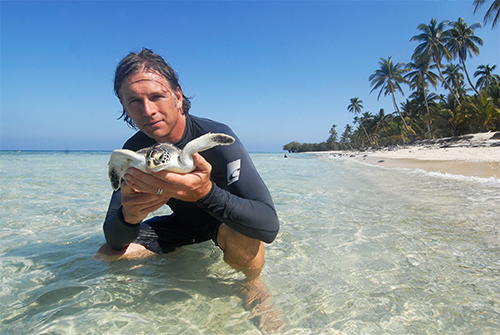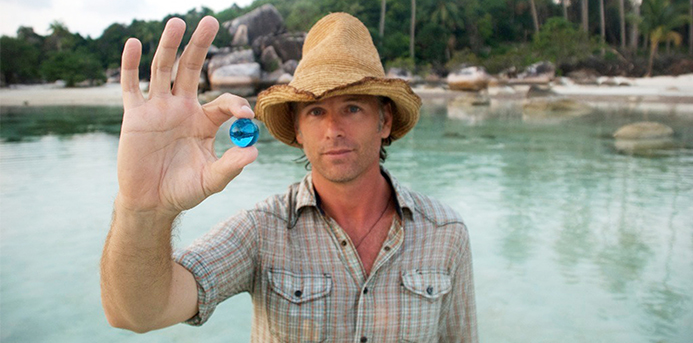How — and why — marine biologist Wallace J. Nichols started a movement inspiring people to share random acts of “blue” gratitude around the world.
The image of Earth captured by the crew of Apollo 17 is a stunning shot of the planet we call home. It is commonly known as the Blue Marble Shot and is considered one of the most reproduced photographs of all time. The Blue Marble has inspired awe for millions, and for one man, it sparked a movement.
That photograph stimulated marine biologist Wallace J. Nichols to start the Blue Marbles Project in 2009. He has since shared blue marbles with millions of people around the world. The marbles celebrate our beautiful and fragile planet and carry the message that water is life.
Nichols also authored the bestseller “Blue Mind: The Surprising Science That Shows How Being Near, In, On, or Under Water Can Make You Happier, Healthier, More Connected, and Better at What You Do.” In a review, The Washington Post described the book as “a fascinating study of the emotional, behavioral, psychological and physical connections that keep humans so enchanted with water. Nichols examines seas and oceans, lakes and rivers, even swimming pools and the contents of our bathtubs in a study that is both highly readable and rooted in real research.” Make It Better recently had the opportunity to talk with Nichols about the Blue Marbles Project and the power of water.
Make It Better: How does the Blue Marbles Project work?
Wallace J. Nichols: I ask people to hold their marble up at arm’s length and ponder it for a second, and realize that’s what we look like from a million miles away — we are small and blue. That’s because we are a water planet. Life comes from water. Water covers three quarters of our planet, most of our body is made of water, our brains are mostly water. While we live on a very small planet relative to the universe, everything we do matters and has impact and ripple effect.
People are then asked to give the marble away to someone as a token of gratitude. You can give it away whenever you like. I gave marbles to two young brothers today and they didn’t want to give them away too quickly. That’s okay. Whenever you give it away, the giver shares a version of the story with the recipient.
Why a blue marble?
A blue marble is a simple, memorable, poignant, physical gift that people remember. It attaches them to the person who gave it, the context, and it feels good.
When you hold the marble up to your eye, you see bubbles and such. It is far more complex than you would first think. Similarly, think about what would be in that amount of seawater, which has every element of the universe in it.

The blue marble serves as a reminder of our physical and biological connection to water and also our cognitive, social and spiritual connection. That’s often left out in my field of ocean advocacy.
How did the Blue Marbles Project begin?
As a marine biologist and ocean advocate, a lot of what I was hearing about and what my colleagues were lecturing about was really bad news. Relentless bad news is not motivating.
I wanted to be useful and helpful. It led me to think differently about how we communicate what is essentially bad news. If your style of communication leads to inaction, that’s not the goal. The more I read about psychology and cognitive science, a positive attitude is incredibly important, even in the face of bad news. If you want to motivate people to get involved and change behavior and be creative, don’t be pessimistic. Be positive.
I gave a lecture at the New England Aquarium in Boston in their IMAX auditorium, which means my slides were seven stories tall. The last slide is the Blue Marble photo. I had passed out blue marbles as people walked in and then at the end as they viewed the image, I told them to take their marble, pass it on to someone to whom they want to say thank you, and tell them a version of the story.
Were you surprised at the initial response to the blue marbles?

The feedback from that talk was better than any other presentation. People told stories about who they gave their marble to. Giving a marble is a really simple, very clear, heartfelt gesture of gratitude.
Gratitude, love and beauty are very motivating. Guilt, fear and too much information aren’t good for building a movement.
I thought this was the best teaching tool I’ve ever used, so I’m going to keep doing it. Then teachers were asking for marbles, and it’s gone from there. We’ve shared 1 million blue marbles all around the world.
What compelled you to write your book, “Blue Mind”?
Thinking about water, looking at water, even the color blue changes us. Get into the bath and it feels good. That feeling is based on a shift in neurochemistry. We often take that for granted. Take a vacation on the water or a walk along Lake Michigan and you feel good. Even if it’s a crummy day, being by the water feels good. As a scientist, I got more curious about why that is.
I thought there would be a book about the psychology of water and I tried to find it. It hadn’t been written. I still wanted to read it, so I tried to get other people to write it. Instead, the message I got back was that I should write it. So I did.
I went from being a marine ecologist studying sea turtle migration to learning a lot about psychology and neuroscience.
You mention the numerous positive effects water has on us, so why is it that we don’t value water as a resource more than we do?
There is a disconnect there and we are all a bit to blame for it. How we teach about nature encourages that disconnect.
We take kids on field trips to lakes, rivers and oceans and teach them about the ecology. As an ecologist, I think that’s important. But we don’t teach them that they are the coowners of the lake, that they can come any time they like and use it to help them calm themselves down or to be inspired to be more creative. Teachers should ask kids, “How do you feel here? How does it feel different than the classroom?”
We should also be teaching the psychological cognitive benefits of having healthy, accessible lakes or rivers nearby. It’s so simple, but so absent from our curricula and teaching. I’m hoping that the textbooks of the future stop leaving it out.

